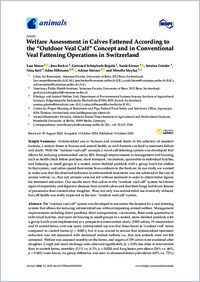Welfare Assessment in Calves Fattened According to the "Outdoor Veal Calf" Concept and in Conventional Veal Fattening Operations in Switzerland.
- Moser L Clinic for Ruminants, Vetsuisse-Faculty, University of Bern, 3012 Bern, Switzerland.
- Becker J Clinic for Ruminants, Vetsuisse-Faculty, University of Bern, 3012 Bern, Switzerland.
- Schüpbach-Regula G Veterinary Public Health Institute, Vetsuisse-Faculty, University of Bern, 3012 Bern, Switzerland.
- Kiener S Clinic for Ruminants, Vetsuisse-Faculty, University of Bern, 3012 Bern, Switzerland.
- Grieder S Ethology and Animal Welfare Unit, Department of Environmental Systems Science, Institute of Agricultural Sciences, Eidgenössische Technische Hochschule (ETH), 8053 Zurich, Switzerland.
- Keil N Centre for Proper Housing of Ruminants and Pigs, Federal Food Safety and Veterinary Office, Agroscope, 8356 Tänikon, Switzerland.
- Hillmann E Ethology and Animal Welfare Unit, Department of Environmental Systems Science, Institute of Agricultural Sciences, Eidgenössische Technische Hochschule (ETH), 8053 Zurich, Switzerland.
- Steiner A Clinic for Ruminants, Vetsuisse-Faculty, University of Bern, 3012 Bern, Switzerland.
- Meylan M Clinic for Ruminants, Vetsuisse-Faculty, University of Bern, 3012 Bern, Switzerland.
- 2020-10-08
Published in:
- Animals : an open access journal from MDPI. - 2020
abomasal ulcers
animal welfare
antimicrobial use
housing
pneumonia
treatment incidence
veal industry
English
The "outdoor veal calf" system was developed to encounter the demand for a veal fattening system that allows for reducing antimicrobial use without impairing animal welfare. Management improvements including direct purchase, short transportation, vaccination, three-week quarantine in individual hutches, and open-air housing in small groups in a roofed, straw-bedded paddock with a group hutch were implemented in a prospective intervention study (1905 calves, 19 intervention and 19 control farms, over one year): antimicrobial use was five times lower in "outdoor veal" farms compared to control farms (p < 0.001), but it was crucial to ensure that antimicrobial treatment reduction was not associated with decreased animal welfare, i.e., that sick animals were not left untreated. Welfare was assessed monthly on the farms, and organs of 339 calves were examined after slaughter. Cough and nasal discharge were observed significantly (p ≤ 0.05) less often in intervention than in control farms, mortality (3.1% vs. 6.3%, p = 0.020) and lung lesion prevalence (26% vs. 46%, p < 0.001) were lower; no group difference was seen in abomasal lesion prevalence (65% vs. 72%). Thus, besides reduced antimicrobial use, calf health and welfare were improved in "outdoor veal calf" farms in comparison to traditional operations.
- Language
-
- English
- Open access status
- gold
- Identifiers
-
- DOI 10.3390/ani10101810
- PMID 33027959
- Persistent URL
- https://folia.unifr.ch/global/documents/123412
Statistics
Document views: 26
File downloads:
- fulltext.pdf: 0
